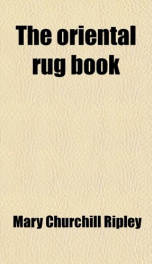the oriental rug book

Purchase of this book includes free trial access to www.million-books.com where you can read more than a million books for free. This is an OCR edition with typos. Excerpt from book: CHAPTER III BIBLIOGRAPHY UNTIL within a century the casual student of tilings Oriental has been apt to look upon Asia chiefly as " Bible country," and through a glass of semi-religious colouring has endeavoured to make the things of long ago explain the life of the intervening centuries. Without doubt the tent of Abraham was similar to those which have been used ever since by nomad tribes, and the curtains before it probably resembled the k/tiliins we know so well to-day, but the modern student has added to his research by considering both Christian and Mohammedan ascendency and would not look upon the art product of to-day as revealing in absolute purity the thought life of the Abrahamic period. More or less, to be sure, racial conditions and methods have obtained in spite of changes brought about by the Cross and the Crescent. The ages were not dark ages, in the Orient, that are chronicled as such in the history of Christian Europe, and the influences from the Orient were felt through the Saracenic conquest, and were noticeable in European art antedating the Crusades. The Christian Dark Ages were explained by writers of Sunday-school text-books, as without light, so far as the development of Christian truth was concerned,and all but the bare outlines of Mohammedan supremacy was eliminated. It must be borne in mind that we are speaking of the way historical facts have influenced art, and are not making an argument for or against methods of dealing with religious truths. Formerly, missionaries with eager desire to establish the Cross in foreign lands, wrote in their books of travel more about converts made than about manners and customs. " Idols" were spoken of indiscriminately as such, without according any individuality to either the man or the animal worshipped. Not un...
Info about the book
Author:
Series:
Unknown
ISBN:
1112214925
Rating:
3/5 (2)Your rating:
0/5
Languge:
English
Users who have this book
Users who want this book
What readers are saying
What do you think? Write your own comment on this book!
write a commentif you like the oriental rug book try:
Other books by this author
Do you want to read a book that interests you? It’s EASY!
Create an account and send a request for reading to other users on the Webpage of the book!

